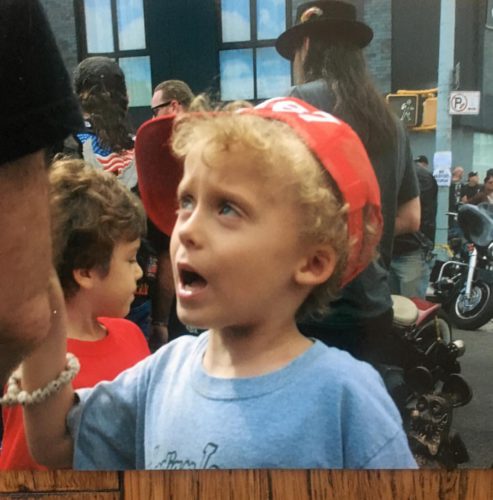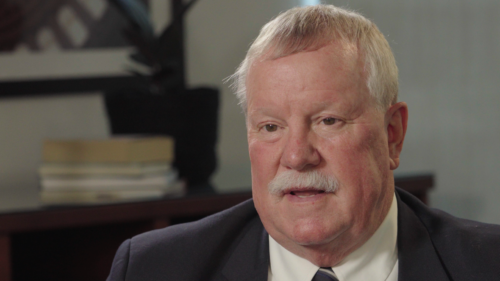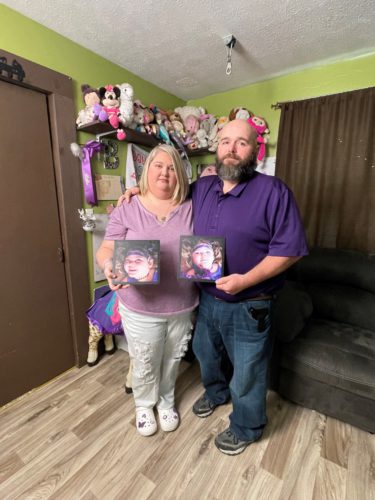By Joce Sterman, Daniela Molina, Jill Riepenhoff, Payton Romans, Olivia Bianco, Ruth Cronin, Caroline Geib, Haley Miller, Mia Stewart and Jasmine Wright
InvestigateTV – Hours after newborn babies enter the world in the United States, cries inevitably ring out when a nurse pricks their heels to draw their blood.
This routine test, where blood is imprinted in five circles on a paper card, is searching for a simple answer: does this baby have a condition that could turn out to be life-changing?

Newborn screening cards wait for processing inside the Texas Department of State Health Services laboratory in Austin.(Joce Sterman, InvestigateTV)
But the state where the baby was born determines what disorders he or she will be screened for, according to an InvestigateTV analysis of federal newborn screening data.
It’s a patchwork of policies across the country that could have dire consequences.
For example, Oklahoma screens for Pompe disease, a genetic condition that impacts the heart and other muscles. Left untreated, babies can die of heart failure before their first birthdays, according to the National Institutes of Health.
But Oklahoma’s neighbors, Arkansas and Texas, do not screen for Pompe disease.
South Carolina screens for a genetic disorder that leads to heart disease, intellectual disabilities and skeletal problems. Babies born with type 1 mucopolysaccharidosis have a shortened lifespan, usually only living into late childhood.
But until last month, neighboring state North Carolina didn’t screen for this condition that is also known as Hurler syndrome. More than a dozen other states also didn’t screen for the condition as of December.
Some parents spend weeks, months, even years searching for a diagnosis, which may have been known soon after birth if their state tested for that particular condition. Katayoun Soleimani was among them.
A few months after her daughter Kiana Soleimani was born in 2013, the baby began missing development milestones. Then came the seizures.
Her mother spent months shuffling her baby to specialists and testing. Whatever was making Kiana ill was so serious that she was hospitalized. Eventually, doctors discovered in 2014 that Kiana had pyruvate carboxylase deficiency, or PCD, a genetic condition that now as a pre-teen has left her unable to walk, talk or sit.
Kiana’s mother wonders what may have been different if her daughter had been tested and diagnosed shortly after birth.
“If it was done earlier, it could help her sooner by at least slowing down the damage,” said Soleimani, who is a dentist in Aliso Viejo, California.
Only two states test for the condition at birth.
‘That one tiny blood spot, we can get so many answers’
Newborn screening started in the 1960s with a test for a condition called phenylketonuria, also known as PKU. The inherited disorder can cause intellectual and developmental disabilities if left untreated.
As a result of newborn screening for PKU, the condition has almost been completely eradicated as a cause of intellectual disabilities, according to the National Institute of Child Health and Human Development.
Fast forward more than half a century and the screening done on millions of newborns every year has expanded to include dozens of conditions. They include well known disorders like cystic fibrosis or sickle cell anemia, and others that are incredibly rare.
As the state laboratory manager for the Texas Department of State Health Services, Susan Tanksley oversees the processing of thousands of newborn screenings each week.
“It’s absolutely critical that every baby is screened. Most of these conditions are incredibly rare,” she said. “So, there’s not generally . . . a family history, or the family may never have even heard of this. A doctor may never have heard of it.”
In the state lab in Austin, those blood-stamped cards are entered into a cataloging system, punched and then run through an assembly line of testing techniques and equipment.
The process is similar in laboratories across the country.

A technician punches a newborn screening card to create samples for testing at the Texas Department of State Health Services laboratory in Austin.(Joce Sterman, InvestigateTV)
Generally, the conditions they’re testing for are part of the Recommended Uniform Screening Panel, or RUSP. The RUSP is a list of disorders that the Secretary of the Department of Health and Human Services recommends states implement as part of their newborn screening programs.
While newborn screening dates back decades, the federal government for the first time put together a formalized list of conditions in 2002 and recommended that states test for them.
That first RUSP list had 29 conditions. Currently, there are 37.
The Advisory Committee on Heritable Disorders in Newborns and Children is charged with making recommendations to the Health Secretary on which conditions states should be screening for.
But those federal recommendations carry no weight. States can pick and choose on their own which conditions will be part of their newborn screenings.
Lack of uniformity means geography dictates life and death newborn testing
The goal of the RUSP recommendations may be uniformity to order to eliminate disparities in newborn screening.
But as of now, there’s very little uniformity, InvestigateTV found.
Geography plays a significant role in what babies are tested for, with each state deciding for itself which screening it can carry out in the face of funding challenges, staff shortages and equipment availability.
Still, the disparities could mean the difference between life and death.
“I can tell you that any newborn screening program is doing the absolute best that they can with the resources that they have and under the constraints that they have,” Tanksley said.
Elisa Seeger is under the firm belief that geography shouldn’t factor into newborn screening.
“Your life shouldn’t be dictated by the ZIP code you live in,” she said.
She lost her son, Aidan, to a rare disease that wasn’t included on the newborn screening panel in her home state of New York when he was born.
Aidan was just six when vision problems began to impact his life.
The need for glasses uncovered other symptoms, which eventually resulted in a diagnosis of adrenoleukodystrophy, or ALD.
The disease first took Aidan’s sight, then his ability to function — and finally in 2012, his life.
“I don’t want another mother to be me. And I don’t want another child to suffer the way he suffered because I can’t really explain how bad that is,” Seeger said.

Aidan Seeger talks with a friend during a block party in 2010, two years before his death from a rare, genetic disorder.(Elisa Seeger)
ALD was not on the federally recommended screening panel when Aidan was born in 2004.
But a year after Aidan’s death, New York became the first state in 2013 to add ALD to its newborn screening panel. Seeger successfully lobbied for state legislation to require it.
Then, in 2016, she was part of a group that helped make the case to add the condition to the RUSP, which would potentially encourage more states to test.
Still more than seven years later, only 35 states and the District of Columbia include the potentially fatal ALD in their newborn screening, according to an InvestigateTV analysis of federal newborn screening data.

Elisa Seeger visits with Sen. Markwayne Mullin, R-Oklahoma, during a trip to Capitol Hill in March as part of her effort to lobby for additional funding for newborn screenings.(Elisa Seeger)
Today, Seeger roams the halls at Capitol Hill to lobby lawmakers about the need for additional funding for newborn screenings. She believes if she had known sooner about Aidan’s condition, treatments could have slowed the progression of his disease.
“They’re already taking those blood spots from the baby’s heels. So, this is something additional at the lab level,” Seeger said. “And it’s just mind boggling to me why this is such a difficult battle.”
Disparities a concern to the federal committee tasked with making screening recommendations
The war to save children is being fought state by state, with borders often creating a dividing line that could be deadly.
InvestigateTV analyzed newborn screening data from the U.S. Health Resources and Services Administration, or HRSA, and found that as of December, not a single state tests for all 37 conditions recommended by the federal government.
Illinois and Missouri each test for 36 of the 37 conditions, the most in the country. Hawaii tests for the fewest RUSP disorders, only 29.
Dr. Ned Calonge is chair of the federal committee that sends the recommendations for newborn screening to the Health Secretary for approval.
“The things that are on the list now, I cannot come up with a health-based reason for them not to be uniformly screened in all 50 states,” Calonge said. “It’s another failure of our health care non-system.”
Calonge told InvestigateTV that his highest priority after becoming chair last year was to try and get every state to implement testing for conditions already on the federal list.

Dr. Ned Calonge, chair of the Advisory Committee on Heritable Disorders in Newborns and Children, talks about the critical need for newborn screening during an interview in Washington, D.C.(Tim Knapp, Gray Television)
Ultimately, although his committee has the power to make recommendations, he realizes it is powerless when it comes to carrying out the testing.
“I would say it’s discouraging and dismaying to have a condition that we have recommended that we feel meets that bar, that those conditions aren’t being tested for,” Calonge said. “You can have two states that are just, you know, one line apart on the map and have very different screening lists.”
The disparities also are a concern for parents who lobbied for years for certain conditions to be included on the RUSP only to be told no.
Kelly Denoy Bonacorsa held her daughter in her arms as she told Calonge’s group last November what it’s like to have a child with Krabbe disease.
“Sofia is one year old, and she is dying,” Bonacorsa told the Advisory Committee on Heritable Disorders in Newborns and Children.
For more than a decade, parents such as Bonacorsa have advocated for Krabbe disease to be included on the recommended list.
“We live in a state that doesn’t screen for Krabbe disease at birth, largely because the disease isn’t on the Recommended Uniform Screening Panel,” Bonacorsa told the committee. “Sadly, Sofia’s diagnosis came too late, and treatment couldn’t help her.”
If Sofia had been screened for Krabbe disease at birth, a bone marrow transplant would have helped her, her mother said.
But instead, Sofia requires round-the-clock medications and receives hospice care for pain management. Bonacorsa said that Sofia’s medical expenses have exceeded half a million dollars.
The committee voted against including Krabbe on the RUSP in February, with a report saying the condition didn’t meet the threshold for inclusion in part because “There is high to moderate certainty that adoption of screening for the targeted condition would have small to zero net benefit”.
As of December, only nine states screened newborns for Krabbe disease. Children born with this genetic disorder often die by age 2.
Differences in newborn screening don’t stop with conditions listed on the RUSP
As with Krabbe disease, many states also require screenings that aren’t on the federal list.
Across the country, InvestigateTV’s analysis found tests are run for 51 conditions that aren’t on the federal list.
For example, only two states screen for HIV, the virus that can cause AIDS.
Fourteen states test for T-cell related lymphocyte deficiencies, a condition in which babies are born with weakened immune systems, which can lead to death without treatment.
Thirty-three states screen for methylmalonic acidemia with homocystinuria, a condition that impacts a baby’s ability to grow and thrive.
But the numbers can be somewhat confusing because for conditions not on the RUSP, there is even less uniformity. Each state has different ways it may count its tests.
“Depending on where you look, you can see differences in the way conditions are counted,” Tanksley, the lab manager, said. “And so it may be that one source counts based on the Recommended Uniform Screening Panel, and one may make count every single way to possibly test you could possibly count it.”
For example, according to state test lists from HRSA, Connecticut tested for 73 total conditions, but Alabama only 31 as of December, though the state has since added two more RUSP conditions and plans to add a third.
Connecticut’s list includes what are called secondary conditions, disorders that may be discovered while testing for a core issue. Alabama’s testing panel listed by HRSA did not contain secondary conditions. The state health department confirms it currently tests for 26 secondary conditions.
The disparities in testing based on the number of potentially affected children is also an issue some advocates point to when trying to get new tests added.
For instance, HRSA data shows 17 states test for a condition known as 2,4 Dienoyl-CoA Reductase Deficiency, but there are only two known cases of the disorder, according to the agency.
Meanwhile, about 20,000 babies are born each year with potentially fatal cytomegalovirus, or CMV, a virus that’s passed from mother to child in the womb. But only one state tests for it, HRSA data shows.
Sarah and Keith Streeval believe testing for CMV, and other rare diseases should be more universal.
“They’re taking the choice away from us when they don’t screen,” Mrs. Streeval said.
The Streeval’s daughter, Bella, was born in Kentucky in 2017 and was diagnosed with CMV shortly after her birth, but not because of routine screening.
At birth, her body was dotted with blue bruises, and she had trouble breathing. Her liver and spleen were enlarged.
“She was very, very sick,” Mrs. Streeval recalled the doctors saying.
She was sent by helicopter to a children’s hospital in Louisville, where testing revealed CMV.

Sarah and Keith Streeval stand in front of a memorial to their daughter, Bella, who died in 2020 from the rare disorder.(Joce Sterman, InvestigateTV)
Caring for Bella was complex and exhausting for her parents, who said she was non-mobile, non-verbal, suffered with seizures and was considered legally blind and profoundly deaf.
Her father says the sound of wind chimes soothed Bella throughout her medical battles, as did the soft feel of a three-foot stuffed giraffe that often sat beside her bed during numerous hospital stays.
“You just take it one day at a time and keep moving forward,” Mr. Streeval told InvestigateTV during a visit to his family’s home near Bowling Green, Kentucky.
The Streevals considered their daughter a superhero, but despite Bella’s best efforts, their little girl couldn’t conquer the disease they’d never heard of before her diagnosis.
She passed away April 7, 2020, but the family’s fight continued.

A memorial to Bella Dawn Streeval grows in front of the Kentucky home where she lived.(Joce Sterman, InvestigateTV)
The Streevals successfully lobbied for a state law named in Bella’s honor.
The legislation, which was signed into law two years to the day following Bella’s death, requires “targeted” CMV screening for newborns, meaning only those who are symptomatic will be tested.
Her parents want to eventually see that requirement expanded to universal CMV testing in Kentucky. And they’ve set their sights on the RUSP as well, hoping to one day see the condition added to the federal list of recommendations.
“We kind of feel like the RUSP is out there, and it’s kind of the magical ending,” Mrs. Streeval said. “But we don’t have a clue when that’s going to happen, so we fight on a state level until we can get there. We don’t know if that will ever come or how long it will take.”
With thousands of babies born each year with CMV, Mrs. Streeval added, “We can’t wait.”
Editors’ Note: This story has been updated to include that North Carolina began screening for Mucopolysaccharidosis type I (Hurler syndrome) in February 2023 and Alabama’s plan to add X-linked adrenoleukodystrophy, Pompe disease, mucopolysaccharidosis type I and adenosine deaminase deficiency (a non-RUSP condition). It also clarifies Alabama’s secondary condition screenings.
Olivia Bianco, Ruth Cronin, Caroline Geib, Haley Miller, Payton Romans, Mia Stewart and Jasmine Wright are with the Arnolt Center for Investigative Journalism at Indiana University and contributed to this story.
Copyright 2023 Gray Media Group, Inc. All rights reserved.


